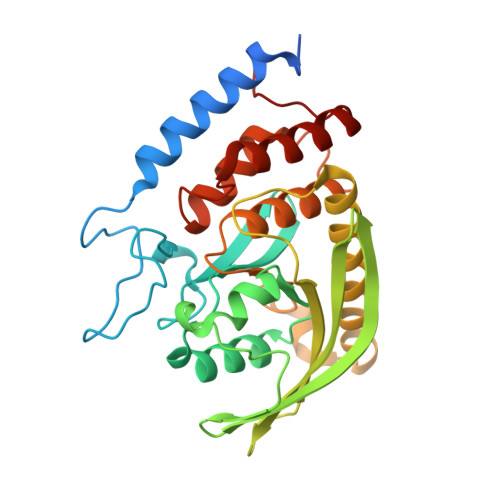Aryl vinyl sulfonates and sulfones as active site-directed and mechanism-based probes for protein tyrosine phosphatases
Liu, S., Zhou, B., Yang, H., He, Y., Jiang, Z.X., Kumar, S., Wu, L., Zhang, Z.Y.(2008) J Am Chem Soc 130: 8251-8260
- PubMed: 18528979
- DOI: https://doi.org/10.1021/ja711125p
- Primary Citation of Related Structures:
3BLT, 3BLU, 3BM8 - PubMed Abstract:
Protein tyrosine phosphatases (PTPs) play key roles in the regulation of normal and pathological processes ranging from cell proliferation, differentiation, metabolism, and survival to many human diseases including cancer and diabetes. Functional studies of PTP can be greatly facilitated by small molecule probes that covalently label the active site of a PTP through an activity-dependent chemical reaction. In this article, we characterize phenyl vinyl sulfonate (PVSN) and phenyl vinyl sulfone (PVS) as a new class of mechanism-based PTP probes. PVSN and PVS inactivate a broad range of PTPs in a time- and concentration-dependent fashion. The PVSN- and PVS-mediated PTP inactivation is active site-directed and irreversible, resulting from a Michael addition of the active-site Cys Sgamma onto the terminal carbon of the vinyl group. Structural and mechanistic analyses reveal the molecular basis for the preference of PVSN/PVS toward the PTPs, which lies in the ability of PVSN and PVS to engage the conserved structural and catalytic machinery of the PTP active site. In contrast to early alpha-bromobenzyl phosphonate-based probes, PVSN and PVS are resistant to solvolysis and are cell-permeable and thus hold promise for in vivo applications. Collectively, these properties bode well for the development of aryl vinyl sulfonate/sulfone-based PTP probes to interrogate PTP activity in complex proteomes.
Organizational Affiliation:
Department of Biochemistry and Molecular Biology, Indiana University School of Medicine, 635 Barnhill Drive, Indianapolis, Indiana 46202, USA.















